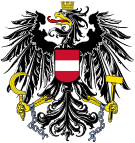| |||||||||||||||||||||||||||||||||||||||||
All 165 seats in the National Council 83 seats needed for a majority | |||||||||||||||||||||||||||||||||||||||||
|---|---|---|---|---|---|---|---|---|---|---|---|---|---|---|---|---|---|---|---|---|---|---|---|---|---|---|---|---|---|---|---|---|---|---|---|---|---|---|---|---|---|
| |||||||||||||||||||||||||||||||||||||||||
 Results of the election, showing seats won by constituency and nationwide. Constituencies are shaded according to the first-place party. | |||||||||||||||||||||||||||||||||||||||||
| |||||||||||||||||||||||||||||||||||||||||
| This article is part of a series on the |
| Politics of Austria |
|---|
 |
Parliamentary elections were held in Austria on 10 May 1959.[1] Although the Socialist Party (SPÖ) received the most votes, the Austrian People's Party won one more seat than the SPÖ. The Communist Party of Austria lost its remaining three seats and has not returned to the National Council since. Voter turnout was 94%.[2] The grand coalition that had governed the country since 1945 remained in office, with People's Party leader Julius Raab as chancellor and Socialist leader Bruno Pittermann as vice-chancellor.
- ^ Nohlen, Dieter; Stöver, Philip (31 May 2010). Elections in Europe: A data handbook. Nomos Verlagsgesellschaft. p. 196. ISBN 978-3-8329-5609-7.
- ^ Nohlen & Stöver, p214




